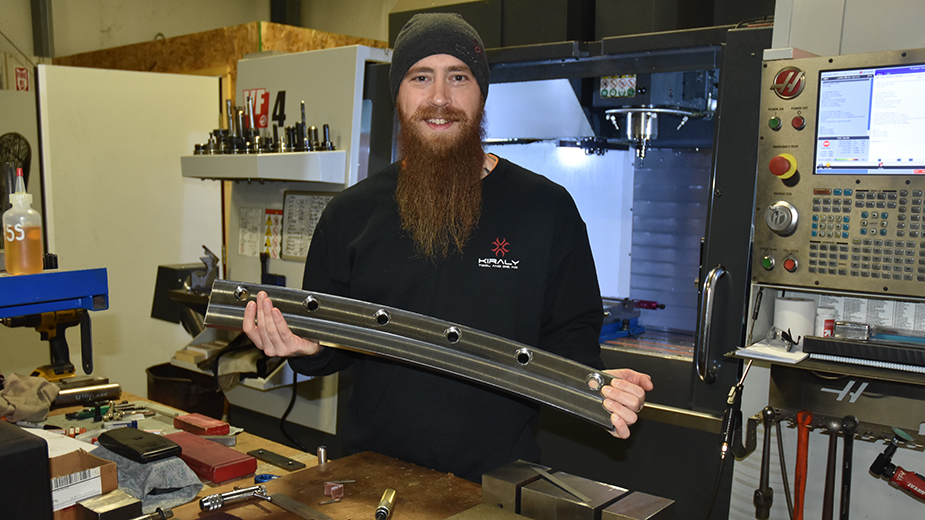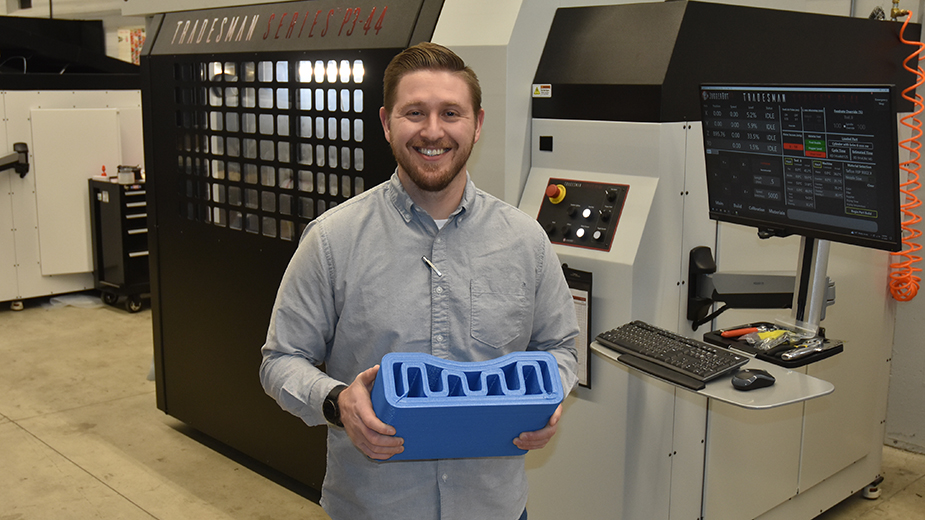YOUNGSTOWN – Raytheon Corp., Lockheed Martin Corp., Boeing Co., Northrop Grumman Corp., General Dynamics Corp. – all represent the pantheon of giant defense contractors whose resources and advanced technological capabilities have transformed the modern U.S. military.
Behind these titans are hundreds of small and medium-size businesses across the country that play no small part in the research, development and manufacturing of critical components that support the defense industry. Moreover, these companies play a pivotal role in keeping intact a supply chain that is indispensable to national security.
At the heart of this network is the National Center for Defense Manufacturing and Machining, an entity that empowers collaboration among the private sector, academia and government to ensure the country’s defense industrial base remains strong.
“You read about the Lockheeds and the Boeings – the ones that get all the press,” says Randy Gilmore, NCDMM vice president and its chief development officer. “But small and medium businesses are also engaged. We were started to give these businesses a chance to compete.”
NCDMM, a subsidiary of the not-for-profit Manufacturing Technology Deployment Group, was established in 2003 as a vehicle to identify the needs of defense manufacturers and develop partnerships to accelerate advanced manufacturing and readiness. Since it was founded, the organization has secured 260 alliance partnerships with institutions of all sizes and expertise – ranging from small businesses with five employees to major research universities, Gilmore says.
“We have software providers, machining providers, machine tool providers. And we have testing laboratories. It’s a pretty impressive list,” he says.
Gilmore notes that these partners bring a certain set of skills to the table from which engineers and others can assess how these companies could fit with a specific defense project.
“When we get a project that requires a specific expertise, we go to our alliance partners and contract them for the duration of the project,” he says. “When the project is over, they go back to their day job and we go back to our day job. We can address a lot of territories that we’re not experts in, via our alliance network.”
Attesting to the organization’s expertise, Gilmore says, “Our first contract was more than 20 years ago, and we’ve renewed the same contract multiple times to the current day.”
NCDMM initially was funded through an appropriation secured by the late U.S. Rep. John Murtha, a Democrat who represented Pennsylvania’s 12th congressional district from 1975 until his death in 2010. The organization is headquartered in Johnstown, Pa.
As the chairman of the defense subcommittee of the House Appropriations Committee, Murtha secured funding for the program under the condition it become self-sufficient within three years. “We were self-sufficient within two,” Gilmore says.
The organization eventually expanded out of western Pennsylvania. In 2012, NCDMM was awarded the first of the country’s advanced manufacturing innovation institutes, America Makes. The Youngstown-based organization spearheads research, awareness and project development through the use of additive manufacturing.
NCDMM has also helped to develop advanced manufacturing programs relative to automation, Gilmore says. While that term often conjures up robotics – the organization has worked on many robotics projects – automation also applies to other facets of defense manufacturing.
“We’ve done automation in assembly line-type work,” such as programs that automatically sand a C-130 aircraft to remove paint, or systems that apply coatings to components to prevent wear or provide stealth technology, he says. The organization has also worked on automation systems used to remove conventional warheads from missiles or grenade-arming programs.
“We work in metrology as well – the measurement of parts,” Gilmore says. “We worked on the F-35 joint strike fighter line to measure parts when they arrived at the factory so you could identify problems before they were needed to go on the aircraft.”
And the organization has extended into machining. On one particular project, NCDMM enlisted the work of three of its alliance partners that were traditional competitors. At issue was how to produce a tool that would extend the life of a cutter for an aircraft manufacturer.
The solution was to use these three companies for isolated functions – one to produce a core for the tool, another to manufacture the cutter for the tool and the other to design the product.
“They didn’t want to deal with each other typically,” Gilmore says. “We were able to make them all work together to come up with a tool that solved a huge problem for the aircraft manufacturer.”
To date, Gilmore estimates that NCDMM has executed more than 5,000 projects over its more than 20 years. “Some of them were $30,000 projects and some of them were $30 million projects,” he says.
For example, the organization has a long-standing relationship with the U.S. Army’s Redstone Arsenal in Huntsville, Ala., where its partners have worked on aviation and missile systems. “We’ve worked on a lot of helicopter and missile applications such as Patriot missiles,” Gilmore says.
NCDMM also works with the U.S. Air Force, the U.S. Navy, and has worked directly with the office of the U.S. Secretary of Defense, he adds. “We’ve branched into almost every style of weapons system that there is. We’ve gone from something as simple as ammunition to missile launching systems.”
NCDMM has established sites in Chambersburg and Murrysville, Pa., Youngstown, Huntsville, Ala., and El Paso, Texas.
At El Paso, the organization established El Paso Makes, an organization charged with bringing companies to that region to serve the defense aerospace industry. The organization worked with U.S. Rep. Veronica Escobar, a Democrat serving the 16th Congressional District, and others to develop a zone that would serve as a location for small and medium-size companies to do business with the defense industry.
“El Paso used to be a vibrant manufacturing community. And then NAFTA happened,” Gilmore says. Manufacturers once entrenched in the border city simply moved operations – in some cases a few hundred yards – to Mexico. “All the manufacturing went right across the border,” he says. “They wanted to find a way to bring business back.”
The solution was to develop an advanced manufacturing hub tied to the defense industry. Any company working for Defense needed to remain within the United States for compliance reasons. “These are businesses that can’t be exported.”
To date, through a collaboration of the city of El Paso, El Paso County, and the University of Texas at El Paso, the project was awarded a $15 million Build to Scale grant, a $40 million Build Back Better federal grant, and a $160 million National Science Foundation grant. Meanwhile, the city donated 250 acres to build an advanced manufacturing district geared toward aerospace and defense.
“It’s in its infancy but the funding is huge,” Gilmore says. “We’re really building up down there.”
INNOVATION AND IMPACT AT HOME
Gilmore says that NCDMM-operated organizations such as America Makes are critical to extending the manufacturing and supply base for the U.S. defense industry. Indeed, in Youngstown, NCDMM oversees not just America Makes, but also the Advanced Manufacturing and Applied Research Innovation Institute, or AMARII.
“Our job at AMARII is to reach out to businesses in the Mahoning Valley,” he says. The idea is to connect with Mahoning Valley manufacturers – whether they are defense related or not – and let them know that the defense industrial base needs small and medium businesses so they remain sustainable, he says.
But smaller companies are often sidelined and kept from doing business with DOD because of costs related to compliance and security. NCDMM and its subsidiaries help small companies that want to contribute to defense by identifying various federal, state or local funding sources that could offset some of these costs.

Zac DiVencenzo, co-founder and president of JuggerBot 3D, based in Youngstown, says two years ago AMARII reached out and asked whether his company would be interested in submitting a project idea.
“I had one already developed,” DiVencenzo says. JuggerBot manufactures industrial-scale 3D printers and had developed technology that includes a hybrid large-scale additive manufacturing system able to print with thermoset composite materials.
The company worked with then-U.S. Rep. Tim Ryan, a Democrat who at the time was vice chairman of the Defense Appropriations subcommittee, to help the submission process along. After board reviews, assessments through AMARII and other litmus tests, DiVencenzo received a call from Ryan in July 2022, informing him that he would submit the project before Congress.
“It got into the budget,” he says and was approved by December 2022. The process to secure funding, however, took another year, he says.
The submission earned the company $4 million in funding to support an initiative with the Air Force Research Laboratory in Dayton. “NCDMM already has a cooperative agreement with Air Force Research Labs,” DiVencenzo says. “Our project could be facilitated through that current agreement.”
Under the agreement, the Air Force Research Lab would own the final product, DiVencenzo says. This year, JuggerBot plans to expand its footprint in downtown Youngstown and add workers. “We’re under contract for 24 months,” he says. “We need to complete it by December 2025,” he says.
The success of companies such as JuggerBot often ripples through the local manufacturing sector.
“We have a constant stream of work from JuggerBot,” says Steve Kiraly, president of Kiraly Tool & Die, Youngstown. The company often performs secondary machining on components printed through additive manufacturing.
It’s a part of the company’s business, Kiraly says. “I sign a lot of NDAs [nondisclosure agreements] with these companies. They can’t tell me what the end use is.”
Between 15% to 20% of the company’s business is additive related, according to Kiraly. He says the company is examining ways to 3D print for other customers and how to incorporate additive manufacturing in its tool designs.
“Part of our success is that we’ve always looked at newer technology,” Kiraly says. “Most of our machines have different options that were not available or affordable five years ago.”
“It’s an exciting time,” he says. “Never did I see it going in this direction this quickly.”
Pictured: Zac DiVencenzo’s company, JuggerBot 3D, won a $4 million contract with the Air Force Research Lab.
